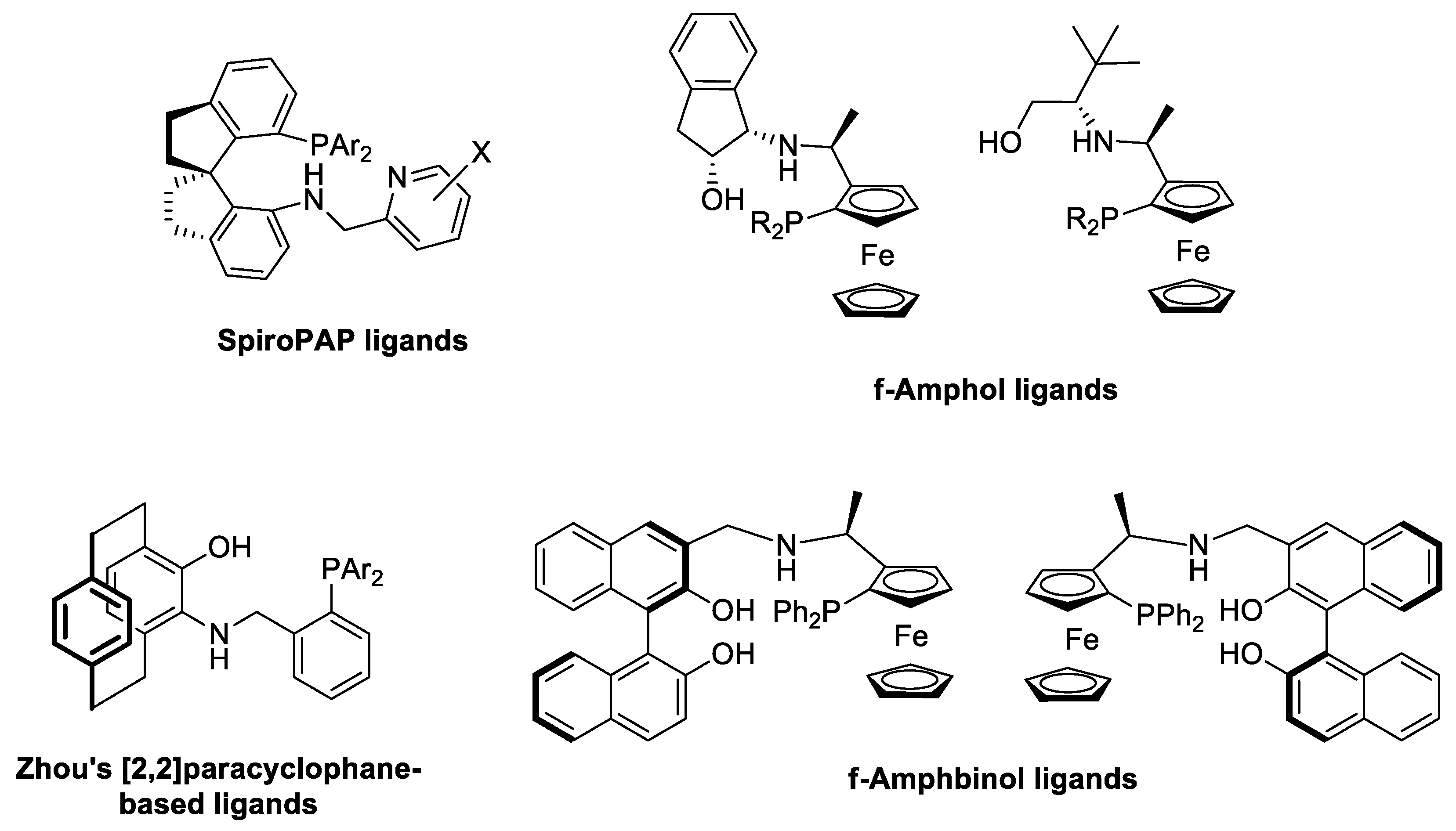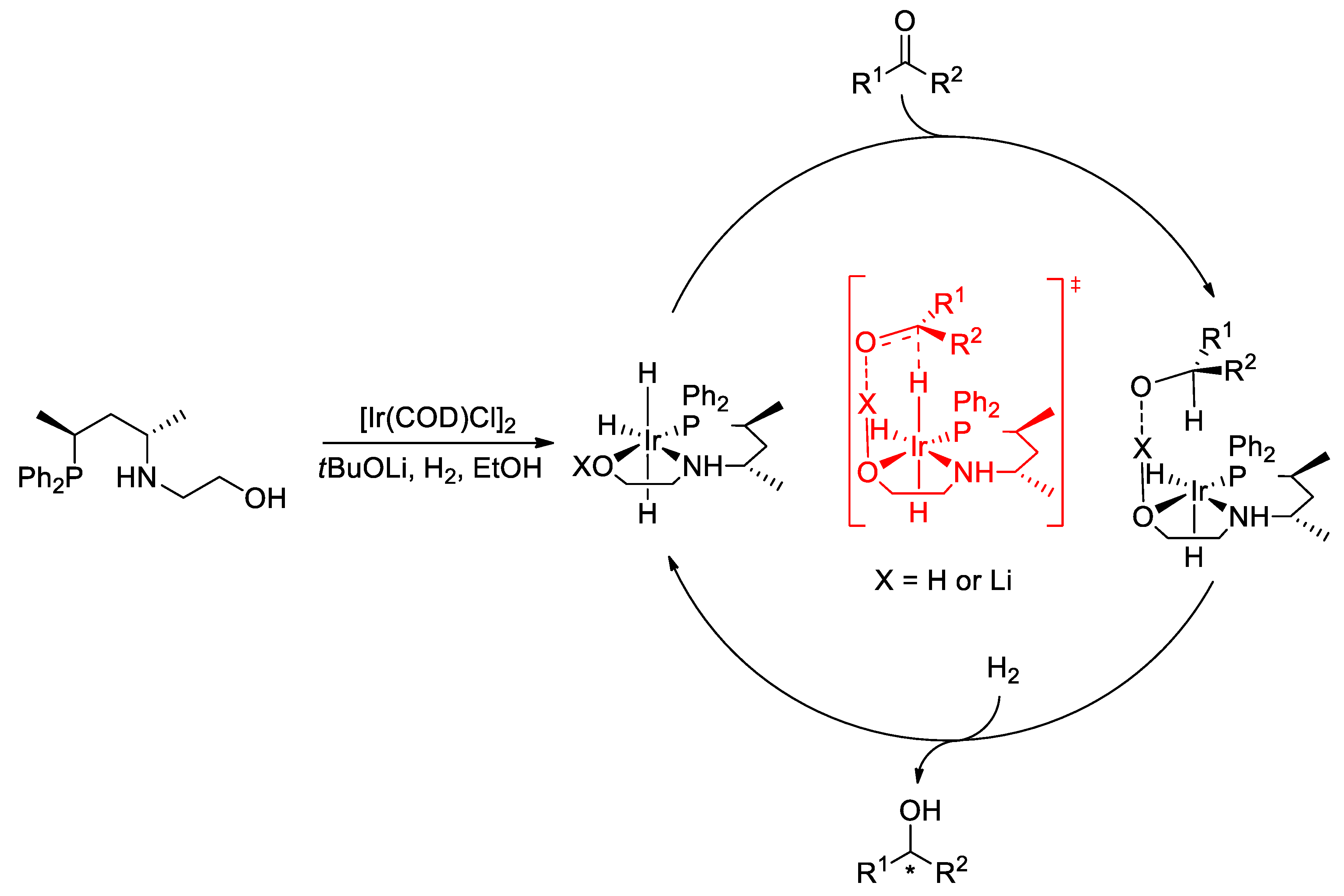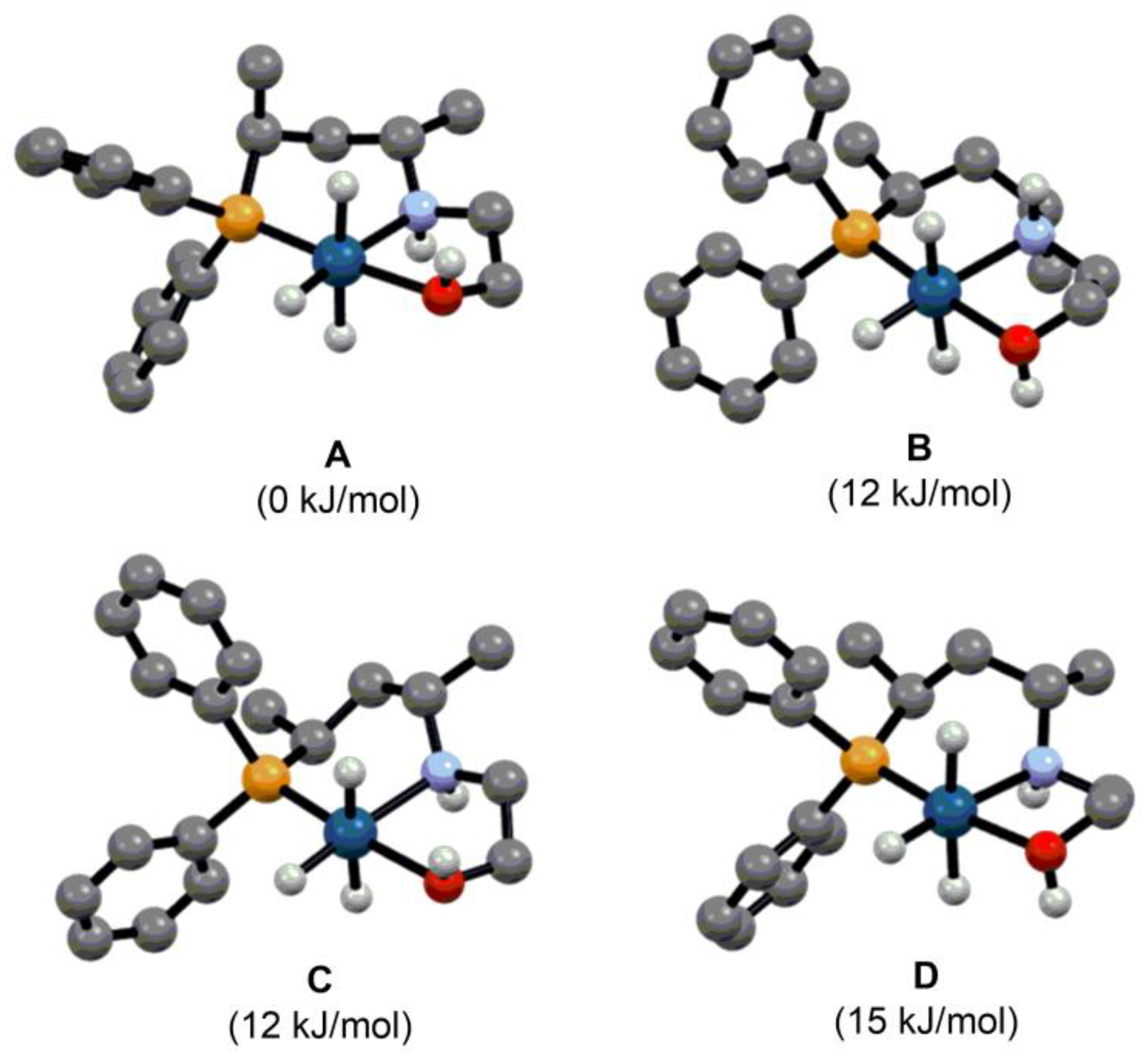Asymmetric Hydrogenation of Ketones by Simple Alkane-Diyl-Based Ir(P,N,O) Catalysts: A Comparative Study
Abstract
1. Introduction
2. Results and Discussion
2.1. Synthesis of the Novel Ligands
2.2. Asymmetric Hydrogenation
3. Materials and Methods
3.1. Synthesis and Characterization of the New Compounds
3.1.1. Synthesis of 3-(((2S,4S)-4-(diphenylphosphino)pentan-2-yl)amino)propan-1-ol (L4)
3.1.2. Synthesis of 2-(((2S,4S)-4-(diphenylphosphino)pentan-2-yl)amino)propane-1,3-diol (L5)
3.1.3. Synthesis of 2-(((2S,3S)-3-(diphenylphosphino)butan-2-yl)amino)ethanol (L7)
3.1.4. Synthesis of (S)-2-((3-(diphenylphosphino)propyl)amino)propan-1-ol (L8)
3.1.5. Synthesis of 2-(((2S,4S)-4-(diphenylphosphino)pentan-2-yl)(methyl)amino)ethanol (L9)
3.1.6. Synthesis of (2R,4R)-4-(diphenylphosphino)-N-(2-methoxyethyl)-N-methylpentan-2-amine (L10)
3.1.7. Synthesis of (2S,4S)-4-(diphenylphosphino)pentan-2-amine (5)
3.1.8. Synthesis of 2-((((2S,4S)-4-(diphenylphosphino)pentan-2-yl)amino)methyl)phenol (L12)
3.2. Asymmetric Hydrogenation
4. Conclusions
Supplementary Materials
Author Contributions
Funding
Institutional Review Board Statement
Informed Consent Statement
Data Availability Statement
Conflicts of Interest
References
- Noyori, R.; Ohkuma, T. Enantioselective ketone and β-Keto Ester hydrogenations (including mechanisms). In The Handbook of Homogeneous Hydrogenation; de Vries, J.G., Elsevier, C.J., Eds.; Wiley-VCH: Weinheim, Germany, 2007; Volume 3, pp. 1105–1163. [Google Scholar] [CrossRef]
- Arai, N.; Ohkuma, T. Reduction of Carbonyl Groups: Hydrogenation. In Science of Synthesis: Stereoselective Synthesis 2, Stereoselective Reactions of Carbonyl and Imino Groups; Molander, G.A., Ed.; Thieme: Stuttgart, Germany, 2010; pp. 9–57. [Google Scholar] [CrossRef]
- Ohkuma, T.; Arai, N. Reduction—Hydrogenation: C=O; Chemoselective. In Comprehensive Chirality; Carreira, E.M., Yamamoto, H., Maruoka, K., Eds.; Elsevier: Amsterdam, The Netherlands, 2012; Volume 5, pp. 270–300. [Google Scholar] [CrossRef]
- Blaser, H.U.; Federsel, H.-J. Asymmetric Catalysis on Industrial Scale: Challenges, Approaches and Solutions, 2nd ed.; Wiley-VCH: Weinheim, Germany, 2010. [Google Scholar]
- Xie, J.-H.; Bao, D.-H.; Zhou, Q.-L. Recent Advances in the Development of Chiral Metal Catalysts for the Asymmetric Hydrogenation of Ketones. Synthesis 2015, 47, 460–471. [Google Scholar] [CrossRef]
- Ratovelomanana-Vidal, V.; Phansavath, P. Asymmetric Hydrogenation and Transfer Hydrogenation; Wiley-VCH: Weinheim, Germany, 2021. [Google Scholar]
- Ohkuma, T.; Ooka, H.; Hashiguchi, S.; Ikariya, T.; Noyori, R. Practical Enantioselective Hydrogenation of Aromatic Ketones. J. Am. Chem. Soc. 1995, 117, 2675–2676. [Google Scholar] [CrossRef]
- Doucet, H.; Ohkuma, T.; Murata, K.; Yokozawa, T.; Kozawa, M.; Katayama, E.; England, A.F.; Ikariya, T.; Noyori, R. trans-[RuCl2(phosphane)2(1,2-diamine)] and Chiral trans-[RuCl2(diphosphane)(1,2-diamine)]: Shelf-Stable Precatalysts for the Rapid, Productive, and Stereoselective Hydrogenation of Ketones. Angew. Chem. Int. Ed. 1998, 37, 1703–1707. [Google Scholar] [CrossRef]
- Yoshimura, M.; Tanaka, S.; Kitamura, M. Recent topics in catalytic asymmetric hydrogenation of ketones. Tetrahedron Lett. 2014, 55, 3635–3640. [Google Scholar] [CrossRef]
- Wang, H.; Wen, J.; Zhang, X. Chiral Tridentate Ligands in Transition Metal-Catalyzed Asymmetric Hydrogenation. Chem. Rev. 2021, 121, 7530–7567. [Google Scholar] [CrossRef]
- Xie, J.-H.; Liu, X.-Y.; Xie, J.-B.; Wang, L.-X.; Zhou, Q.-L. An Additional Coordination Group Leads to Extremely Efficient Chiral Iridium Catalysts for Asymmetric Hydrogenation of Ketones. Angew. Chem. Int. Ed. 2011, 50, 7329–7332. [Google Scholar] [CrossRef]
- Xie, J.-B.; Xie, J.-H.; Liu, X.-Y.; Zhang, Q.-Q.; Zhou, Q.-L. Chiral Iridium Spiro Aminophosphine Complexes: Asymmetric Hydrogenation of Simple Ketones, Structure, and Plausible Mechanism. Chem. Asian J. 2011, 6, 899–908. [Google Scholar] [CrossRef]
- Peris, E.; Crabtree, R.H. Key factors in pincer ligand design. Chem. Soc. Rev. 2018, 47, 1959–1968. [Google Scholar] [CrossRef] [PubMed]
- Liang, D.-H.; Hou, C.-J.; Li, Q.; Qin, H.; Li, L.; Hu, X.-P. Chiral P,N,N-Ligands for Asymmetric Hydrogenation. Adv. Synth. Catal. 2024, 366, 2165–2185. [Google Scholar] [CrossRef]
- Philips, S.D.; Fuentes, J.A.; Clarke, M.L. On the NH Effect in Ruthenium-Catalysed Hydrogenation of Ketones: Rational Design of Phosphine-Amino-Alcohol Ligands for Asymmetric Hydrogenation of Ketones. Chem. Eur. J. 2010, 16, 8002–8005. [Google Scholar] [CrossRef]
- Fuentes, J.A.; Philips, S.D.; Clarke, M.L. New phosphine-diamine and phosphine-amino-alcohol tridentate ligands for ruthenium catalysed enantioselective hydrogenation of ketones and a concise lactone synthesis enabled by asymmetric reduction of cyano-ketones. Chem. Cent. J. 2012, 6, 151–156. [Google Scholar] [CrossRef]
- Yu, J.; Duan, M.; Wu, W.; Qi, X.; Xue, P.; Lan, Y.; Dong, X.-Q.; Zhang, X. Readily Accessible and Highly Efficient Ferrocene-based Amino-phosphine-alcohol (f-Amphol) Ligands for Iridium-Catalyzed Asymmetric Hydrogenation of Simple Ketones. Chem. Eur. J. 2017, 23, 970–975. [Google Scholar] [CrossRef]
- Gu, G.; Lu, J.; Yu, O.; Wen, J.; Yin, Q.; Zhang, X. Enantioselective and Diastereoselective Ir-Catalyzed Hydrogenation of α-Substituted β-Ketoesters via Dynamic Kinetic Resolution. Org. Lett. 2018, 20, 1888–1892. [Google Scholar] [CrossRef]
- Yin, C.; Dong, X.-Q.; Zhang, X. Iridium/f-Amphol-catalyzed Efficient Asymmetric Hydrogenation of Benzo-fused Cyclic Ketones. Adv. Synth. Catal. 2018, 360, 4319–4324. [Google Scholar] [CrossRef]
- Niu, T.; Liu, L.-X.; Wu, B.; Zhou, Y.-G. Synthesis of Tridentate PNO Ligands with Planar Chirality and Application in Iridium-Catalyzed Asymmetric Hydrogenation of Simple Ketones. J. Org. Chem. 2023, 88, 7863–7871. [Google Scholar] [CrossRef] [PubMed]
- Wu, W.; Zhao, N.; Liu, Y.; Du, S.; Wang, X.; Mo, W.; Yan, X.; Xu, C.; Zhou, Y.; Ji, B. Iridium Catalysts with f-Amphbinol Ligands: Highly Stereoselective Hydrogenation of a Variety of Ketones. Org. Lett. 2023, 25, 8845–8849. [Google Scholar] [CrossRef]
- Yu, J.; Long, J.; Yang, Y.; Wu, W.; Xue, P.; Chung, L.W.; Dong, X.-Q.; Zhang, X. Iridium-Catalyzed Asymmetric Hydrogenation of Ketones with Accessible and Modular Ferrocene-Based Amino-phosphine Acid (f-Ampha) Ligands. Org. Lett. 2017, 19, 690–693. [Google Scholar] [CrossRef]
- Yu, J.; Huang, F.; Fang, W.; Yin, C.; Shi, C.; Lang, Q.; Chen, G.-Q.; Zhang, X. Discovery and development of ferrocene-based tetradentate ligands for Ir-catalysed asymmetric hydrogenation of ketone. Green Synth. Catal. 2022, 3, 175–178. [Google Scholar] [CrossRef]
- Ma, J.; Li, W.; He, L.; Lv, H. Iridium-catalyzed chemoselective asymmetric hydrogenation of conjugated enones with ferrocene-based multidentate phosphine ligands. Chem. Commun. 2022, 58, 5841–5844. [Google Scholar] [CrossRef]
- Yin, C.; Jiang, Y.-F.; Huang, F.; Xu, C.-Q.; Pan, Y.; Gao, S.; Chen, G.-Q.; Ding, X.; Bai, S.-T.; Lang, Q.; et al. A 13-million turnover-number anionic Ir-catalyst for a selective industrial route to chiral nicotine. Nat. Commun. 2023, 14, 3718. [Google Scholar] [CrossRef]
- Császár, Z.; Guóth, M.; Farsang, E.; Bényei, A.C.; Bakos, J.; Farkas, G. Hydrogen bond-directed coordination of phosphine-amino-alcohol (P,N,OH) ligands: Stereochemical considerations and catalytic studies. Inorg. Chim. Acta 2022, 543, 121153. [Google Scholar] [CrossRef]
- Császár, Z.; Pőrgye, Z.E.; Tóth-Farsang, E.; Kovács, M.; Bényei, A.C.; Bakos, J.; Farkas, G. Ruthenium-complexes of new chiral phosphine-amine-ether (Ru-PNO) for asymmetric hydrogenation—The role of backbone chirality in pincer ligand design. Appl. Organomet. Chem. 2024, 38, e7379. [Google Scholar] [CrossRef]
- Eschweiler, W. Ersatz von an Stickstoff gebundenen Wasserstoffatomen durch die Methylgruppe mit Hülfe von Formaldehyd. Ber. Dsch. Chem. Ges. 1905, 38, 880–882. [Google Scholar] [CrossRef]
- Clarke, H.T.; Gillespie, H.B.; Weisshaus, S.Z. The Action of Formaldehyde on Amines and Amino Acids. J. Am. Chem. Soc. 1933, 55, 4571–4587. [Google Scholar] [CrossRef]
- Balogh, S.; Farkas, G.; Tóth, I.; Bakos, J. Synthesis of new N-substituted chiral phosphine-phosphoramidite ligands and their application in asymmetric hydrogenations and allylic alkylations. Tetrahedron Asymm. 2015, 26, 666–673. [Google Scholar] [CrossRef]
- Richards, C.J.; Arthurs, R.A. Catalyst Optimisation for Asymmetric Synthesis by Ligand Chirality Element Addition: A Perspective on Stereochemical Cooperativity. Chem. Eur. J. 2017, 23, 11460–11478. [Google Scholar] [CrossRef] [PubMed]
- Farkas, G.; Császár, Z.; Stágel, K.; Nemes, E.; Balogh, S.; Tóth, I.; Bényei, A.; Lendvay, G.; Bakos, J. Efficient Stereochemical Communication in Phosphine-Amine Palladium-Complexes: Exploration of N-Substituent Effects in Coordination Chemistry and Catalysis. J. Organomet. Chem. 2017, 846, 129–140. [Google Scholar] [CrossRef]
- Szi-Ferenc, L.; Császár, Z.; Lendvay, G.; Bényei, A.; Balogh, S.; Nánási, B.; Farkas, G.; Bakos, J. Synthesis of zwitterionic phosphapalladacycles: Unusual reactivity pattern of six-membered P,N-chelates. Organometallics 2018, 37, 2203–2206. [Google Scholar] [CrossRef]
- García, N.; Jaseer, E.A.; Munarriz, J.; Sanz Miguel, P.J.; Polo, V.; Iglesias, M.; Oro, L.A. An Insight into Transfer Hydrogenation Reactions Catalysed by Iridium(III) Bis-N-heterocyclic Carbenes. Eur. J. Inorg. Chem. 2015, 2015, 4388–4395. [Google Scholar] [CrossRef]
- Császár, Z.; Szabó, E.Z.; Bényei, A.C.; Bakos, J.; Farkas, G. Chelate ring size effects of Ir(P,N,N) complexes: Chemoselectivity switch in the asymmetric hydrogenation of α,β-unsaturated ketones. Catal. Commun. 2020, 146, 106128. [Google Scholar] [CrossRef]
- Ramspoth, T.-F.; Kootstra, J.; Harutyunyan, S.R. Unlocking the potential of metal ligand cooperation for enantioselective transformations. Chem. Soc. Rev. 2024, 53, 3216–3223. [Google Scholar] [CrossRef] [PubMed]
- Choualeb, A.; Lough, A.J.; Gusev, D.G. Hemilabile Pincer-Type Hydride Complexes of Iridium. Organometallics 2007, 26, 5224–5229. [Google Scholar] [CrossRef]
- Anastas, P.T.; Kirchhoff, M.M. Origins, Current Status, and Future Challenges of Green Chemistry. Acc. Chem. Res. 2002, 35, 686–694. [Google Scholar] [CrossRef]
- Beaver, M.G.; Caille, S.; Içten, E.; Michalak, S.E.; St-Pierre, G.; Thiel, O.R. Green Chemistry as a Driver for Innovation in the Pharmaceutical Industry. Isr. J. Chem. 2021, 61, 369–379. [Google Scholar] [CrossRef]
- Wang, Z.-J.; Zhou, H.-F.; Wang, T.-L.; He, Y.-M.; Fan, Q.-H. Highly enantioselective hydrogenation of quinolines under solvent-free or highly concentrated conditions. Green Chem. 2009, 11, 767–769. [Google Scholar] [CrossRef]
- Clapham, S.E.; Guo, R.; Iuliis, M.Z.; Rasool, N.; Lough, A.; Morris, R.H. Probing the Effect of the Ligand X on the Properties and Catalytic Activity of the Complexes RuHX(diamine)(PPh3)2 (X = OPh, 4-SC6H4OCH3, OPPh2, OP(OEt)2, CCPh, NCCHCN, CH(COOMe)2; diamine = 2,3-Diamino-2,3-dimethylbutane, (R,R)-1,2-Diaminocyclohexane). Organometallics 2006, 25, 5477–5486. [Google Scholar] [CrossRef]
- Wan, X.; Sun, Y.; Luo, Y.; Li, D.; Zhang, Z. Synthesis of a Bulky and Electron-Rich Derivative of SEGPhos and Its Application in Ru-Catalyzed Enantioselective Hydrogenation of β-Ketoesters. J. Org. Chem. 2005, 70, 1070–1072. [Google Scholar] [CrossRef] [PubMed]
- Wu, W.; Liu, S.; Duan, M.; Tan, X.; Chen, C.; Xie, Y.; Lan, Y.; Dong, X.-Q.; Zhang, X. Iridium Catalysts with f-Amphox Ligands: Asymmetric Hydrogenation of Simple Ketones. Org. Lett. 2016, 18, 2938–2941. [Google Scholar] [CrossRef]
- Linag, Z.-Q.; Yang, T.-L.; Gu, G.; Dang, L.; Zhang, X. Scope and Mechanism on Iridium f-Amphamide Catalyzed Asymmetric Hydrogenation of Ketones. Chin. J. Chem. 2018, 36, 851–856. [Google Scholar] [CrossRef]
- Bartoszewicz, A.; Marcos, R.; Sahoo, S.; Inge, A.K.; Zou, X.; Martín-Matute, B. A Highly Active Bifunctional Iridium Complex with an Alcohol/AlkoxideTethered N-Heterocyclic Carbene for Alkylation of Amines with Alcohols. Chem. Eur. J. 2012, 18, 14510–14519. [Google Scholar] [CrossRef]
- Gu, G.; Yang, T.; Yu, O.; Qian, H.; Wang, J.; Wen, J.; Dang, L.; Zhang, X. Enantioselective Iridium-Catalyzed Hydrogenation of α-Keto Amides to α-Hydroxy Amides. Org. Lett. 2017, 19, 5920–5923. [Google Scholar] [CrossRef] [PubMed]
- Zhang, L.; Tang, Y.; Han, Z.; Ding, K. Lutidine-Based Chiral Pincer Manganese Catalysts for Enantioselective Hydrogenation of Ketones. Angew. Chem. Int. Ed. 2019, 58, 4973–4977. [Google Scholar] [CrossRef] [PubMed]
- Liu, W.-P.; Yuan, M.-L.; Yang, X.-H.; Li, K.; Xie, J.-H.; Zhou, Q.-L. Efficient asymmetric transfer hydrogenation of ketones in ethanol with chiral iridium complexes of spiroPAP ligands as catalysts. Chem. Commun. 2015, 51, 6123–6125. [Google Scholar] [CrossRef]
- More, G.V.; Badgujara, K.C.; Bhanage, B.M. Kinetic resolution of secondary alcohols with Burkholderia cepacia lipase immobilized on a biodegradable ternary blend polymer matrix as a highly efficient and heterogeneous recyclable biocatalyst. RSC Adv. 2015, 5, 4592–4598. [Google Scholar] [CrossRef]
- Császár, Z.; Kovács, R.; Fonyó, M.; Simon, J.; Bényei, A.; Lendvay, G.; Bakos, J.; Farkas, G. Testing the role of the backbone length using bidentate and tridentate ligands in manganese-catalyzed asymmetric hydrogenation. Mol. Catal. 2022, 529, 112531. [Google Scholar] [CrossRef]
- Qin, C.; Hou, C.-J.; Liu, H.; Liu, Y.-J.; Huang, D.-Z.; Hu, X.-P. Ir-catalyzed asymmetric hydrogenation of simple ketones with chiral ferrocenyl P,N,N-ligands. Tetrahedron Lett. 2018, 59, 719–722. [Google Scholar] [CrossRef]
- Contente, M.L.; Molinari, F.; Zambelli, P.; De Vitis, V.; Gandolfi, R.; Pinto, A.; Romano, D. Biotransformation of aromatic ketones and ketoesters with the non-conventional yeast Pichia glucozyma. Tetrahedron Lett. 2014, 55, 7051–7053. [Google Scholar] [CrossRef]
- Collados, J.F.; Ortiz, P.; Pérez, J.M.; Xia, Y.; Koenis MA, J.; Buma, W.J.; Nicu, V.P.; Harutyunyan, S.R. Enantiospecific Brook Rearrangement of Tertiary Benzylic α-Hydroxysilanes. Eur. J. Org. Chem. 2018, 2018, 3900–3903. [Google Scholar] [CrossRef]
- Komagawa, H.; Maejima, Y.; Nagano, T. Sodium Bromide-Catalyzed Oxidation of Secondary Benzylic Alcohols Using Aqueous Hydrogen Peroxide as Terminal Oxidant. Synlett 2016, 27, 789–793. [Google Scholar] [CrossRef]
- Frisch, M.J.; Trucks, G.W.; Schlegel, H.B.; Scuseria, G.E.; Robb, M.A.; Cheeseman, J.R.; Scalmani, G.; Barone, V.; Mennucci, B.; Petersson, G.A.; et al. Gaussian, Inc.: Wallingford, CT, USA, 2009.
- Yanai, T.; Tew, D.; Handy, N. A new hybrid exchange–correlation functional using the Coulomb-attenuating method (CAM-B3LYP). Chem. Phys. Lett. 2004, 393, 51–57. [Google Scholar] [CrossRef]
- Andrae, D.; Häußermann, U.; Dolg, M.; Stoll, H.; Preuß, H. Energy-adjustedab initio pseudopotentials for the second and third row transition elements. Theor. Chim. Acta 1990, 77, 123–141. [Google Scholar] [CrossRef]
- Hehre, W.J.; Ditchfield, R.; Pople, J.A. Self-Consistent Molecular Orbital Methods. XII. Further Extensions of Gaussian-Type Basis Sets for Use in Molecular Orbital Studies of Organic Molecules. J. Chem. Phys. 1972, 56, 2257–2261. [Google Scholar] [CrossRef]
- Hariharan, P.C.; Pople, J.A. The influence of polarization functions on molecular orbital hydrogenation energies. Theor. Chim. Acta 1973, 28, 213–222. [Google Scholar] [CrossRef]
- Francl, M.M.; Pietro, W.J.; Hehre, W.J.; Binkley, J.S.; Gordon, M.S.; DeFrees, D.J.; Pople, J.A. Self-consistent molecular orbital methods. XXIII. A polarization-type basis set for second-row elements. J. Chem. Phys. 1982, 77, 3654–3665. [Google Scholar] [CrossRef]
- Gordon, M.S.; Binkley, J.S.; Pople, J.A.; Pietro, W.J.; Hehre, W.J. Self-consistent molecular-orbital methods. 22. Small split-valence basis sets for second-row elements. J. Am. Chem. Soc. 1982, 104, 2797–2803. [Google Scholar] [CrossRef]
- Tomasi, J.; Mennucci, B.; Cammi, R. Quantum Mechanical Continuum Solvation Models. Chem. Rev. 2005, 105, 2999–3094. [Google Scholar] [CrossRef]








 | |||||
|---|---|---|---|---|---|
| Entry | Base | B/C Molar Ratio | Solvent | Conversion (%) | ee (%) a |
| 1 | tBuOLi | 5 | iPrOH | 76 | 88 |
| 2 | tBuOK | 5 | iPrOH | >99 | 82 |
| 3 | tBuOLi | 10 | iPrOH | >99 | 92 |
| 4 | tBuOLi | 20 | iPrOH | >99 | 92 |
| 5 | KOH | 10 | iPrOH | >99 | 80 |
| 6 | tBuOLi | 10 | MeOH | 98 | 72 |
| 7 | tBuOLi | 10 | EtOH | >99 | 94 |
| 8 | tBuOLi | 10 | nBuOH | >99 | 95 |
| 9 | tBuOLi | 10 | γ-valerolactone | 3 | 60 |
| 10 | tBuOLi | 10 | 2-Me-THF | 9 | 39 |
| 11 | tBuOLi | 10 | 96% EtOH | >99 | 93 |
| 12 b | tBuOLi | 10 | EtOH | >99 | 95 |
| Substrate Concentration (mmol Acetophenone/mL Ethanol) | Conversion (%) | ee (%) |
|---|---|---|
| 5 | >99 | 94 |
| 10 | >99 | 94 |
| 20 | >99 | 93 |
| 50 | >99 | 92 |
| 100 | >99 | 90 |
Disclaimer/Publisher’s Note: The statements, opinions and data contained in all publications are solely those of the individual author(s) and contributor(s) and not of MDPI and/or the editor(s). MDPI and/or the editor(s) disclaim responsibility for any injury to people or property resulting from any ideas, methods, instructions or products referred to in the content. |
© 2024 by the authors. Licensee MDPI, Basel, Switzerland. This article is an open access article distributed under the terms and conditions of the Creative Commons Attribution (CC BY) license (https://creativecommons.org/licenses/by/4.0/).
Share and Cite
Császár, Z.; Guóth, M.; Kovács, M.; Bényei, A.C.; Bakos, J.; Farkas, G. Asymmetric Hydrogenation of Ketones by Simple Alkane-Diyl-Based Ir(P,N,O) Catalysts: A Comparative Study. Molecules 2024, 29, 3743. https://doi.org/10.3390/molecules29163743
Császár Z, Guóth M, Kovács M, Bényei AC, Bakos J, Farkas G. Asymmetric Hydrogenation of Ketones by Simple Alkane-Diyl-Based Ir(P,N,O) Catalysts: A Comparative Study. Molecules. 2024; 29(16):3743. https://doi.org/10.3390/molecules29163743
Chicago/Turabian StyleCsászár, Zsófia, Mária Guóth, Margit Kovács, Attila C. Bényei, József Bakos, and Gergely Farkas. 2024. "Asymmetric Hydrogenation of Ketones by Simple Alkane-Diyl-Based Ir(P,N,O) Catalysts: A Comparative Study" Molecules 29, no. 16: 3743. https://doi.org/10.3390/molecules29163743
APA StyleCsászár, Z., Guóth, M., Kovács, M., Bényei, A. C., Bakos, J., & Farkas, G. (2024). Asymmetric Hydrogenation of Ketones by Simple Alkane-Diyl-Based Ir(P,N,O) Catalysts: A Comparative Study. Molecules, 29(16), 3743. https://doi.org/10.3390/molecules29163743







